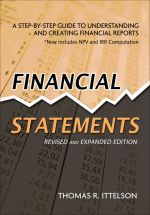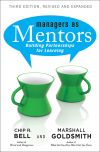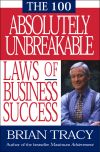Правообладателям!
Представленный фрагмент книги размещен по согласованию с распространителем легального контента ООО "ЛитРес" (не более 20% исходного текста). Если вы считаете, что размещение материала нарушает ваши или чьи-либо права, то сообщите нам об этом.Читателям!
Оплатили, но не знаете что делать дальше?
Текст бизнес-книги "Financial Statements"
Автор книги: Ittelson Thomas
Раздел: Зарубежная деловая литература, Бизнес-книги
Возрастные ограничения: +12
Текущая страница: 1 (всего у книги 1 страниц)
Thomas R. Ittelson
Financial Statements
“A witty, concise and delightfully logical guide for the high-tech entrepreneur. Everything you need to know, but not a line more. I’m already recommending it to the faculty, students and business colleagues who are starting companies.”
Lita NelsenDirector, Technology Licensing OfficeMassachusetts Institute of TechnologyCambridge, Massachusetts
“I wish this book were around when I started my first company. The entrepreneur can learn in one evening’s reading what it took me two years of learning-by-doing! I plan on giving a copy to every CEO in our venture fund’s portfolio.”
Gordon B. BatyPartner, Zero Stage CapitalCambridge, Massachusetts

 5 Star Reviews from Amazon.com Readers
5 Star Reviews from Amazon.com Readers
The Best Book on Financial Statements, Period! Wow, what a great book! I’m a technical professional and now no longer in the financially confused majority.
– Robert I. Hedges (Burnsville, MN)
Simply the Best! Clearly the first introductory book one should read. This book – a must on every managers shelf – adds value by providing clear and concise definitions and relates them visually to the changing financial statements. A tremendous bang for buck. Simply go get it and read it.
– ClimbHigh
The author has a gift that few experts have . He anticipates all my newbie/beginner stupid questions… As soon as the little voice in my head asks, “But why did they do it this way?” the author gives me the answer. This book has been of enormous value to me. It is an essential reference for anyone who needs to understand what business finances are about.
– M. Kramer (United States)
A Masterpiece. Every single financial term is clarified with a layman’s language. Moreover, for every single term, there is a very understandable example. Likewise, in every page there is a sheet explaining all the transactions. I strongly believe that this book is a masterpiece for non-financial managers.
– a reader
Excellent! I purchased this book for an MBA course and ended up using it more than the assigned text. The author makes a complicated subject seem like child’s play!
– Bill Holcomb (Cleveland, OH)
Perfect book when first learning… This is a wonderfully clear and concise introduction to the interpretation of financial statements… Read this if you are not a CPA or MBA, but must “get a handle” on Balance Sheets, Income Statements and Cash Flow Statements. This should be the first book you buy.
– Jack Fossen (Dallas, TX)
Outstanding!! Looking to understand how financial statements work?..then purchase this book —there’s none better. I am a graduate student nearing the completion of my MBA degree. The author speaks in basic terms about what financial statements mean and how they work. This book puts it all together for the reader.
– Joseph P. Gallagher (Bellinghan, WA)
A very useful book . While the book gets only skin deep on accounting concepts, it does an excellent job in deconstructing how the Income Statement, Statement of Cash Flows, and Balance Sheet are changed. Very few accounting related books make explicit what happens the way this book does.
– R. Chonchol (Florida)
Want to understand financial statements? I took an accounting class…and I had difficulty interpreting financial statements. So I gambled and bought this book with a hope to unravel the mystery on financial statements. It really worked! Overall, the knowledge gained exceeds multiple folds of the time and money invested on this book!
– Tuan minh Tran
Excellent, buy it!! If you are in the finance business, of any kind, and you are not an accountant, this book is for you.
– Richard Gomez (San Diego, CA)
WOW, Incredible. I took an accounting course at University, I now wish that my professor used this book in the course. So easy to understand and with great examples. Suitable for anyone who wants to learn accounting the fast and easy way.
– Kavkazy (Toronto, Canada)
I dedicate this book to Alesdair, who has had the good sense to become a lawyer and not an accountant
Acknowledgments
Many people helped make this book possible. My special thanks go to Isay Stemp, who first showed me that knowing a little finance and accounting could be fun; to my agent, Michael Snell, who taught me how to write a book proposal; and to Lisa Berkman, whose encouragement was invaluable as I drafted this revised and expanded edition.
Many thanks to my publisher, Ronald Fry of Career Press, for seeing promise in a preliminary version of this book and to Kristen Parkes, editorial director for Career Press, for her guiding of this book through to publication.
Again with this second edition, as was the case with the first, I am indebted to my colleague Jack Turner for his thoughtful review of the words and numbers in this book. Also a special thanks to Graham Eacott for his careful reading and correction of the first edition.
These clients, colleagues and friends at one time or another helped me to develop (whether they realized it or not) the concepts presented in this book. My thanks to Gwen Acton, Marci Anderson, Molly Downer, Tim Duncan, Cavas Gobhai, Jack Haley, Katherine Leahey, Paul McDonough, Lita Nelsen, Paul O’Brien, Mel Platte, and Iruna and Chris Simmons.
Preface
If the first edition of this book was an entrepreneurial business, it would be a huge success. Now over 100,000 copies of Financial Statements: A Step-by-Step Guide to Understanding and Creating Financial Reports are in-press and helping non-financial managers and students of accounting and finance cope with the “numbers of business.”
With this new revised second edition, we have expanded the book into five sections from the original three. Many readers of the first edition wanted to better understand capital investment decision-making, which is the focus of our two new sections.
Capital is often a company’s scarcest resource, and using capital wisely is essential for success. The chief determinant of what a company will become is the capital investments it makes today. So in this new edition, we will use the financial analysis techniques of net present value (NPV) and internal rate of return (IRR) as capital investment decision-making tools
Preface to the First Edition:
We needed to hire an accountant to keep the books at a venture-capital backed, high-technology startup of which I was a founder and CEO. I interviewed a young woman – just out of school – for the job and asked her why she wanted to become an accountant. Her answer was a surprise to all of us,
“Because accounting is so symmetrical, so logical, so beautiful and it always comes out right,” she said.
We hired her on the spot, thinking it would be fun to have almost-a-poet keeping our books. She worked out fine.
I hope you take away from this book a part of what my young accountant saw. Knowing a little accounting and financial reporting can be very, very satisfying. Yes, it does all come out right at the end, and there is real beauty and poetry in its structure.

But let’s discuss perhaps the real reason you’ve bought and are now reading this book. My bet is that it has to do with power. You want the power you see associated with knowing how numbers flow in business.
Be it poetry or power, this accounting and financial reporting stuff is not rocket science. You’ve learned all the math required to master accounting by the end of the fourth grade – mostly addition and subtraction with a bit of multiplication and division thrown in to keep it lively.
The specialized vocabulary, on the other hand, can be confusing. You will need to learn the accounting definitions of revenue, income, cost and expense. You’ll also need to understand the structure and appreciate the purpose of the three major numeric statements that describe a company’s financial condition.
Here’s a hint: Watch where the money flows; watch where goods and services flow. Documenting these movements of cash and product is all that financial statements do. It is no more complicated than that. Everything else is details.
But why is it all so boring, you ask? Well, it’s only boring if you do not understand it. Yes, the day-to-day repetitive accounting tasks are boring. However, how to finance and extract cash from the actions of the enterprise is not boring at all. It is the essence of business and the generation of wealth.
Not boring at all.
Introduction
Many non-financial managers have an accounting phobia …a financial vertigo that limits their effectiveness. If you think “inventory turn” means rotating stock on the shelf, and that “accrual” has something to do with the Wicked Witch of the West, then this book’s for you.
Financial Statements: A Step-by-Step Guide to Understanding and Creating Financial Reports is designed for those business professionals (1) who know very little about accounting and financial statements, but feel they should, and those (2) who need to know a little more, but for whom the normal accounting and financial reporting texts are mysterious and unenlightening. In fact, the above two categories make up the majority of all people in business. You are not alone.
Financial Statements: A Step-by-Step Guide to Understanding and Creating Financial Reports is a transaction-based, business training tool with clarifying, straightforward, real-life examples of how financial statements are built and how they interact to present a true financial picture of the enterprise.
We will not get bogged down in details that get in the way of conceptual understanding. Just as it is not necessary to know how the microchips in your computer work to multiply a few numbers, it’s not necessary to be a Certified Public Accountant (CPA) to have a working knowledge of the “accounting model of the enterprise.”

Transactions. This book describes a sequence of “transactions” of our sample company, AppleSeed Enterprises, Inc., as it goes about making and selling delicious applesauce. We will sell stock to raise money, buy machinery to make our product, and then satisfy our customers by shipping wholesome applesauce. We’ll get paid and we will hope to make a profit. Then we will expand the business.
Each step along the way will generate account “postings” on AppleSeed’s books. We’ll discuss each transaction to get a hands-on feel for how a company’s financial statements are constructed. We’ll learn how to report using the three main financial statements of a business – the
“Accounting is a language, a means of communicating among all the segments of the business community. It assumes a reference base called the accounting model of the enterprise. While other models of the enterprise are possible, this accounting model is the accepted form, and is likely to be for some time.
“If you don’t speak the language of accounting or feel intuitively comfortable with the accounting model, you will be at a severe disadvantage in the business world. Accounting is a fundamental tool of the trade.”
Gordon B. BatyEntrepreneurshipPrentice Hall, Englewood Cliffs, NJ, 1990
Financial Statements
Balance Sheet, Income Statement and Cash Flow Statement – for these common business dealings:
1. selling stock
2. borrowing money
3. receiving orders
4. shipping goods
5. invoicing customers
6. receiving payments
7. paying sales commissions
8. writing off bad debts
9. prepaying expenses
10. ordering equipment
11. paying deposits
12. receiving raw materials
13. scrapping damaged product
14. paying suppliers
15. booking manufacturing variances
16. depreciating fixed assets
17. valuing inventory
18. hiring staff and paying salary, wages and payroll taxes
19. computing profit
20. paying income taxes
21. issuing dividends
22. acquiring a business
23. and more
By the end of this book, you’ll know your way around the finances of our applesauce-making company, AppleSeed Enterprises, Inc.
Goals. My goal in writing this book is to help people in business master the basics of accounting and financial reporting. This book is especially directed at those managers, scientists and salespeople who should know how a Balance Sheet, Income Statement and Cash Flow Statement work…but don’t.
Your goal is to gain knowledge of accounting and finance to assist you in your business dealings. You want the power that comes from understanding financial manipulations. You must know how the score is kept in business. You recognize, as Gordon Baty says, you must “feel intuitively comfortable with the accounting model” to succeed in business.

This book is divided into five main sections, each with a specific teaching objective:
Section A. Financial Statements: Structure & Vocabular y will introduce the three main financial statements of the enterprise and define the special vocabulary that is necessary to understand the books and to converse with accountants.
Section B. Transactions: Exploits of AppleSeed Enterprises, Inc. will take us through 31 business transactions, showing how to report financial impact of each on the Balance Sheet, Income Statement and Cash Flow Statement of AppleSeed Enterprises.
Section C. Financial Statements: Construction & Analysis will subject the financial statement of our sample company to a rigorous analysis using common ratio analysis techniques. Then finally we will touch on how to “cook the books,” why someone would want to, and how to detect financial fraud.
“…even if it’s boring and dull and soon to be forgotten, continue to learn double-entry bookkeeping. People think I’m joking, but I’m not. You should love the mathematics of business.”
Kenneth H. Olsenentrepreneurial founder of Digital Equipment Corporation
Section D. Business Expansion: Strategy, Risk & Capital will describe the strategic decisions that a fledgling company must make when it expands. We will answer the questions, “Where will we get the money?” and “How much will it cost?”
Then in Section E. Making Good Capital Investment Decisions we will analyze business expansion alternatives and select the best using sophisticated net present value (NPV) techniques.

With your newly acquired understanding of the structure and flow of money in business, you will appreciate these important business quandaries:
• How an enterprise can be rapidly growing, highly profitable and out of money all at the same time…and why this state of affairs is fairly common.
• Why working capital is so very important and which management actions lead to more, which lead to less.
Конец ознакомительного фрагмента.
Текст предоставлен ООО «ЛитРес».
Прочитайте эту книгу целиком, купив полную легальную версию на ЛитРес.
Безопасно оплатить книгу можно банковской картой Visa, MasterCard, Maestro, со счета мобильного телефона, с платежного терминала, в салоне МТС или Связной, через PayPal, WebMoney, Яндекс.Деньги, QIWI Кошелек, бонусными картами или другим удобным Вам способом.
Внимание! Это ознакомительный фрагмент книги.
Если начало книги вам понравилось, то полную версию можно приобрести у нашего партнёра - распространителя легального контента ООО "ЛитРес".Правообладателям!
Представленный фрагмент книги размещен по согласованию с распространителем легального контента ООО "ЛитРес" (не более 20% исходного текста). Если вы считаете, что размещение материала нарушает ваши или чьи-либо права, то сообщите нам об этом.Читателям!
Оплатили, но не знаете что делать дальше?






